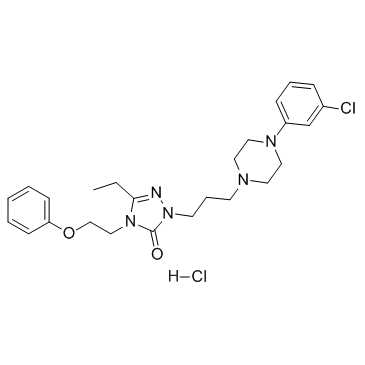Nefazodone hydrochloride

Nefazodone hydrochloride structure
|
Common Name | Nefazodone hydrochloride | ||
|---|---|---|---|---|
| CAS Number | 82752-99-6 | Molecular Weight | 506.46800 | |
| Density | N/A | Boiling Point | 599.6ºC at 760 mmHg | |
| Molecular Formula | C25H33Cl2N5O2 | Melting Point | 186-188ºC | |
| MSDS | Chinese USA | Flash Point | 316.4ºC | |
|
Systematic evaluation of commercially available ultra-high performance liquid chromatography columns for drug metabolite profiling: optimization of chromatographic peak capacity.
J. Chromatogr. A. 1374 , 122-33, (2014) The present study investigated the practical use of modern ultra-high performance liquid chromatography (UHPLC) separation techniques for drug metabolite profiling, aiming to develop a widely applicable, high-throughput, easy-to-use chromatographic method, wi... |
|
|
The relation between changes in patients' interpersonal impact messages and outcome in treatment for chronic depression.
J. Consult. Clin. Psychol. 80(3) , 354-64, (2012) Interpersonal theories posit that chronically depressed individuals have hostile and submissive styles in their social interactions, which may undermine their interpersonal effectiveness and maintain their depression. Recent findings support this theory and a... |
|
|
Comparison of the bioactivation potential of the antidepressant and hepatotoxin nefazodone with aripiprazole, a structural analog and marketed drug.
Drug Metab. Dispos. 36(6) , 1016-29, (2008) In vitro metabolism/bioactivation of structurally related central nervous system agents nefazodone (hepatotoxin) and aripiprazole (nonhepatotoxin) were undertaken in human liver microsomes in an attempt to understand the differences in toxicological profile. ... |
|
|
Inhibition of G protein-activated inwardly rectifying K+ channels by different classes of antidepressants.
PLoS ONE 6(12) , e28208, (2011) Various antidepressants are commonly used for the treatment of depression and several other neuropsychiatric disorders. In addition to their primary effects on serotonergic or noradrenergic neurotransmitter systems, antidepressants have been shown to interact... |
|
|
Dyadic discord at baseline is associated with lack of remission in the acute treatment of chronic depression.
Psychol. Med. 40(3) , 415-24, (2010) Dyadic discord, while common in depression, has not been specifically evaluated as an outcome predictor in chronic major depressive disorder. This study investigated pretreatment dyadic discord as a predictor of non-remission and its relationship to depressiv... |
|
|
The Psychopharmacology Algorithm Project at the Harvard South Shore Program: an update on posttraumatic stress disorder.
Harv. Rev. Psychiatry 19(5) , 240-58, (2011) This project aimed to provide an organized, sequential, and evidence-supported approach to the pharmacotherapy of posttraumatic stress disorder (PTSD), following the format of previous efforts of the Psychopharmacology Algorithm Project at the Harvard South S... |
|
|
Redistribution of slow wave activity of sleep during pharmacological treatment of depression with paroxetine but not with nefazodone.
J. Sleep Res. 18(3) , 342-8, (2009) It has been suggested that increase in delta sleep ratio (DSR), a marker for the relative distribution of slow wave activity (SWA) over night time, is associated with clinical response to antidepressant treatment. We examined this index and its relationship t... |
|
|
Differential effects of treatments for chronic depression: a latent growth model reanalysis.
J. Consult. Clin. Psychol. 78(3) , 409-19, (2010) Psychotherapy-pharmacotherapy combinations are frequently recommended for the treatment of chronic depressive disorders. Our aim in this novel reanalysis of archival data was to identify patient subgroups on the basis of symptom trajectories and examine the c... |
|
|
A preliminary trial: double-blind comparison of nefazodone, bupropion-SR, and placebo in the treatment of cannabis dependence.
Am. J. Addict. 18(1) , 53-64, (2009) The present study investigated the efficacy of nefazodone and bupropion-sustained release for treating cannabis dependence. A double-blind, placebo-controlled, piggy back design was employed to assess if nefazodone and bupropion-sustained release increased th... |
|
|
The use of monoamine pharmacological agents in the treatment of sexual dysfunction: evidence in the literature.
J. Sex. Med. 8(4) , 956-70, (2011) The monoamine neurotransmitters serotonin, dopamine, and norepinephrine play an important role in many medical and psychological conditions, including sexual responsiveness and behavior. Pharmacological agents that modulate monoamines may help alleviate sexua... |